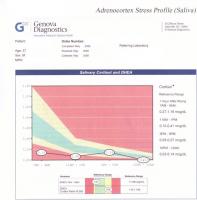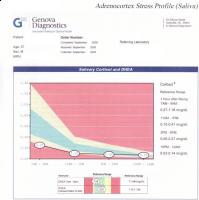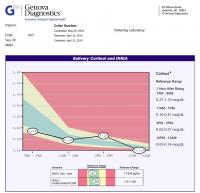Health Check 3 - Tuesday, three days after ending six months on Cycloastragenol - Cortisol and DHEAHere I have data from two earlier tests as well. I've presented them earlier in this mail thread, but excluded the graphs. Here the results are again, including the graphs.
BACKGROUNDRecap from one of my earlier posts, to give some background about the first two testsI've been been working as an IT-consultant in a stressful environment for many years, the last four or five of them very stressful. I therefore took two DHEA-S/Cortisol tests some time back (about half a year apart). The first was very bad, with a cortisol-time-curve indicating levels too close to indicate addison's disease for comfort. After this test I started to take Astragalus (standardised Astragalus Root Extract (0.5% glucosides, 70% polysaccharides) 225 mg, Raw Astragalus Root Powder 250 mg). First once a day, but soon three times a day (morning, lunch, evening). I also took Ginkgo biloba L. 100 mg (24 mg ginkgoflavonidglycosides , 6 mg terpenoids) twice daily. When retaking the DHEA-S/Cortisol test about half a a year later it was, if not good, at least measurable better. The amount of stress experienced during the period was unchanged.Comments on the results from the lab which supports my statement about stressA pattern showing one or more decreased cortisol levels, while the level of DHEA is within the reference range, is clinically significant. The pattern suggests adrenal hypofunction of the zona fasciculata (the primary source of cortisol). At this time there is no evidence of hyperfunction of the zona reticularis (the primary source of DHEA). A degree of adrenal hypofunction is suggested, which has been noted in fatigue disorders, physiological or psychological stress, anxiety, hypotension and/or hypoglycemia.The third testAfter the second test I did half a year on AIV+GB+Orlistat and half a year on Cycloastragenol+GB+Orlistat and then I took the test again
First half year 3 months - AIV 3x33mg only
3 months - AIV 1x100mg + Chitosan, Orlistat 3x120mg and Gingko Biloba 1x100mg
Second half yearCykloastragenol during two periods of 3 months, with a two week interval in between. During both periods I used Cycloastragenol 1x5mg (including Chitosan 1mg), Gingko Biloba 1x100mg, Orlistat 2-3x120mg.
The amount of stress during all of the above periods have been pretty much constant, working a lot of overtime and not allowing for a real rest period.
ANALYSIS/COMMENTSDHEABetween the first, the second test and the third test the level of DHEA increased from
137 to
158 to
223. According to the Wikipedia entry on DHEA, the substance decrease in the body with about 2% each year after you have turned 25. This mean that the combination of substances above would seem to have increased my level of DHEA, even though it should have been declining. Because I did not take Orlistat during the first increase of DHEA, I think the effect might be attributed to either Astragalus and/or Gingko Biloba.
Wikipedia also states that
as most DHEA is produced by the zona reticularis of the adrenal, it is argued that there is a role in the immune and stress response. This might mean that a higher level of DHEA helps the body to handle stress and maybe just returned my DHEA to the levels where they should have been if it wasn't for the negative effects of stress. This might also explain why the cortisol values got better with each test. As I will show in my next posting (also posted before), the telomeres in my immune system cells were in pretty good shape some time after I took the second test (except for my Natural Killer Cells). Wikipedia also states that
the researches found that low levels of DHEA-s showed a significant association with shorter lifespan and that higher DHEA-s levels are a "strong predictor" of longevity in men, even after adjusting for age, blood pressure, and plasma glucose, which might support some kind of relation between the lengths of telomeres and the changes of levels of DHEA.
The lab had the following comments on the DHEA-results on the last test
DHEA is within the reference range. Proper levels contribute to the ideal metabolism of proteins, carbohydrates and
fats, including efficient glycemic control.
The ratio of DHEA to cortisol is normal. This ratio indicates a relative balance of the adrenal output of androgens
and cortisol. Both of the hormones are released in response to ACTH from the pituitary and a normal ratio indicates a
balanced function of the hypothalamic-pituitary-adrenal axis.CortisolThe cortisol levels of the first test was not very good. They were outright bad. After almost half a year on a standardized Astragalus extract + Gingko Biloba they showed a significant improvement. After continuing on AIV/Cycloastragenol for another year, they have mostly improved even more. The exception is the late night cortisol, which the lab considers to be a baseline value.
Specifically, the lab have the following comments on the cortisol levels for each time of the day on the last test:
In this profile, the 7-9 AM cortisol level is within the reference range. Because cortisol levels are typically at their
peak shortly after awakening, morning cortisol may be a good indicator of peak adrenal gland function. Morning
cortisol levels within reference range suggest a component of normal adrenal function with regard to peak circadian
activity.
The 11 AM-1 PM cortisol level is within the reference range. Mid-day cortisol levels may be a good indication of
adaptive adrenal gland function since they represent the adrenal glands' response to the demands of the first few hours
of the day. Mid-day cortisol levels within reference range suggest a component of normal adrenal function in regard to
adaptive response.
The 3-5 PM cortisol level is within the reference range. Afternoon cortisol levels may be a good indication of the
adrenal glands' ability to help regulate blood sugar, since they represent a postprandial sample. Afternoon levels
within the reference range suggest normal adrenal function, especially in the area of glycemic control.
The 10 PM-12 AM cortisol level is below the reference range. Late-night cortisol levels may be a good indication of
baseline adrenal gland function since they typically represent the lowest level during the day. Low late-night cortisol
levels suggest a degree of adrenal fatigue with regard to baseline circadian activity.
I recently got the results from the flow-FISH test on my telomere lengths after completing six months on Cycloastragenol. I will post them as soon as I get some time.































 This topic is locked
This topic is locked






















